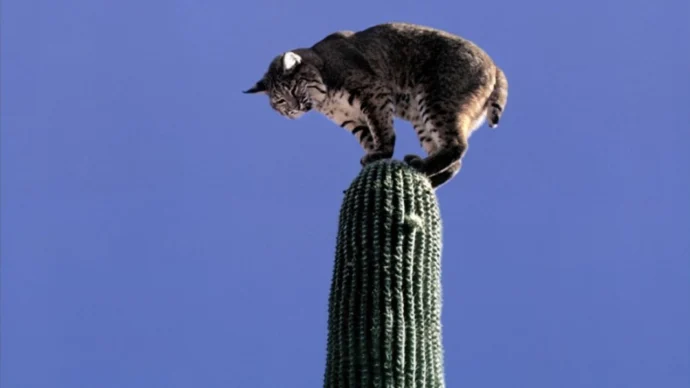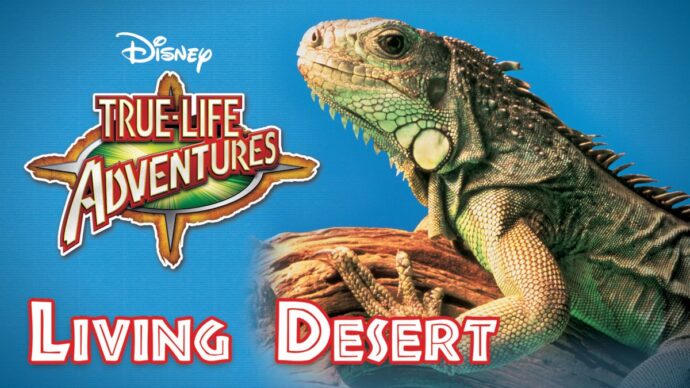Plus or Minus is a series detailing and analyzing every feature film now streaming on Disney+. It combines the unique history all these films share, their cultural impacts, and their qualities, or lack thereof. From timeless classics, to acquired hits, to DCOMs, no stone will be left unturned.
This Plus or Minus on The Living Desert is a special one. Over the first few entries, we’ve mainly looked at animated features and one live-action piece. Well, we return to live-action, but with a new twist. For the first time ever, we are in the world of nature documentaries. A topic that is plentiful on Disney+ and will be a relatively common fixture here on Plus or Minus. This is not the first documentary we have covered on this series, if you count The Reluctant Dragon as one. But this is the start of the “True-Life Adventures” series. A long series of documentaries that are just as integral to the Disney company as their animated films and live-action spectacles, and its effects are still felt today. However, before diving into The Living Desert specifically, we need to bring up context.
The Beginning of Nature Documentaries
Depicting nature and animals through cinema has been around since the beginning of the medium. Not just through narrative works, but educational and documentary works. But for our purposes, an early pioneer in nature docs we know today comes from Swedish filmmaker Arne Sucksdorff. Sucksdorff made numerous short films throughout the 1940s that showcased Swedish wildlife in a sympathetic way. While before animals in films were used as spectacles in man vs. nature tales, Sucksdorff’s films dramatized animals and their behaviors. They were shown as characters dealing with struggles, featured scenes of comedy, and boasted unique musical scores that showed their individuality as characters. All of this is common not just in Disney’s nature films, but nature programming in general.
There’s more to the story of Arne Sucksdorff, but it’s important to recognize that what he crafted in his early works was the blueprint for Walt’s newest venture, the True-Life Adventures. These were a series of nature documentary films, short and full-length, which showcased animals across the world and taught viewers about them through an “edutainment” lens.
The Importance of True-Life
It’s unknown why Walt Disney was interested in these documentaries. Fair to say it was a genuine interest in these locales and fauna, but more likely came down to costs. When the first True-Life Adventure arrived in 1948, Disney was still under financial woes and documentaries are considerably cheaper to make, especially compared to animated movies. Having a few cheap projects fill up the slate like this was the fiscal way to go. And in the beginning, these consisted of 30-minute shorts, making them even cheaper. Almost all of them would win the Academy Award for Best Short Subject (Two-Reel), adding prestige to the brand. Some of these shorts, such as In Beaver Valley and The Olympic Elk, are available to stream on Disney+.
By 1953, these True-Life Adventures would expand into feature films, starting with The Living Desert. This 69-minute film depicts the Southwestern United States and all the animals that inhabit that area. The bobcat, the road runner, the tarantula, and many more who live in the territory. But despite the extra length and broader scope, it was still the same True-Life Adventures audiences knew and loved. It still showcased animal behaviors through footage gathered by scientific advisors and nature filmmakers, while still framing them under classic Disney storylines. All through a charming narrator who brought corny charm and jokes into the fray. More on this later.
Longer, Different, and the Same All at Once
Like the shorts, The Living Desert was directed by James Algar, a director on segments for both Fantasia and Bambi. This was also written and narrated by Winston Hibler, the screenwriter for Cinderella, Alice in Wonderland, and Peter Pan. But what’s unique from the shorts was its distributor. Beforehand, Disney had a deal with RKO Pictures to distribute their films, including the True-Life Adventure series. Yet due to RKO’s money troubles, in turn leading to their closure in 1959, Walt Disney used The Living Desert as his first independently-distributed film, under the company name Buena Vista Distribution. We now call this Walt Disney Studios Motion Pictures, which does not roll off the tongue very well.
And despite being a new distributor, The Living Desert was a tremendous success. At a budget of $300,000, the film had grossed at least $2.6 million, earning a very strong profit. International box office was also strong. Particularly in Japan, where it earned more money than Gone with the Wind. Six more films in the True-Life Adventures series were made, and though the brand is now defunct, it still lives on through new names. In 2007, Disneynature was created for a similar purpose of the Mouse House distributing their own nature documentary films. This subsidiary is not as popular as Marvel or Lucasfilm, but is still actively producing movies almost every Earth Day, although they now go straight to streaming.
Meanwhile, since the 21st Century Fox merger in 2019, Disney now owns National Geographic, which has consistently put out nature-themed movies and shows for years. And of course, the True-Life Adventures DNA can be found outside Disney. Both in the works of Jacques Cousteau and David Attenborough, as well as Discovery Channel and Animal Planet.
Legacy vs. Quality
The True-Life Adventures are important for a number of reasons. For documentaries, for Disney, for nature in general. But important does not always mean good. And as a 2022 viewer, I would be lying if I found The Living Desert all that engaging. It was for sure groundbreaking in its time. But looking at it today, this film is dated and forgettable. And perhaps it’s unfair to compare it to the decades of material since its release. Things can only improve when you lay the groundwork. Yet there are many fundamental flaws here that shows there’s more to the problem.
The storytelling here is pretty basic, even for a nature film. Most nature programs or films depict all aspects of an animal’s life, including their habits, diets, and life cycles. Yet in The Living Desert, the animals are mentioned…and that’s it. We learn a little bit about each animal featured and how they interact with other animals in the desert. But the film’s broad scope means we have to rush to a new character with little time to breathe or even learn. So even as an educational piece, while it’s there, it’s not all that engaging or impactful.

Plus the film is corny. Really corny. There’s nothing wrong with classic Disney cheese sprinkled into a movie. Yet the film boasts obnoxious music that never stops and stupid jokes one after another. The worst moment is a battle between two scorpions set to annoying hoedown music. All the while, Winston Hibler goes country, “yeehaw” and all. It’s laughably stupid and frankly feels like a cheap tactic to make kids pay attention.
Making science and nature interesting to young viewers is always a challenge. But I don’t think this is the right angle. It frankly feels patronizing to its younger audience.
Is it Legit?
Yet perhaps the most damning issue with The Living Desert is something I can’t necessarily prove, yet is important to bring up. Is the footage of The Living Desert genuine? Documentaries are always under scrutiny for their legitimacy. They use editing techniques to manipulate events all the time, so one can argue every documentary is doctored footage. Still, when watching one, it’s fair to expect you’re being told the truth. And I don’t think that’s always the case.
There are moments where footage is edited to make a joke. Tar pits bubbling up in time with the music, the aforementioned scorpion hoedown. Those are annoying and clear fabrications. Yet they are not as bad as you may think. They’re clearly silly jokes and not intended to show the real world. However, there are moments that feel manipulated. Sometimes the editing gets schizophrenic or the interactions feel forced. Like a camera crew is making these animals interact so a scene can happen.
In the grand scheme of things, a dopey documentary forcing animal confrontations isn’t the end of the world. And if you know anything about a certain True Life Adventure, you know Disney has done more egregious stuff with this franchise. But a cardinal sin broken is a cardinal sin broken. And it frankly makes the film look worse than it already is.
Plus or Minus?
As I wrap up this Plus or Minus, I’m maybe too harsh on The Living Desert. It’s not necessarily lying or saying anything harmful. The facts are still accurate, so some editing manipulation isn’t that bad, right? It’s very corny, but that’s just how it was done. And it’s trying to appeal to a wide audience, so that makes it fine?
In 1953, I get the appeal. There was nothing like it, and it showcased nature in a fun way. And there’s an audience for hokey fun and education, even if this film’s education feels drab and basic. But the problem here is that there’s nothing that stands out about it anymore. We live in a world where companies pump these out like a machine. And frankly, those machines do a better job educating and entertaining audiences young and old.
Why go back to this old documentary when the topics in here are explored much better elsewhere? Including on Disney+? National Geographic’s made a dynasty detailing nature and animals in fun and exciting ways for decades. And generally speaking, the specials they make do well in tackling what this stodgy one-hour film barely tries.
It may have influenced and intrigued some kids, but this is a disappointing Minus for me.
Next Time: We’re on another True-Life Adventure, this time with The Vanishing Prairie. Could this fix my criticisms, or is this another tragic Minus?
